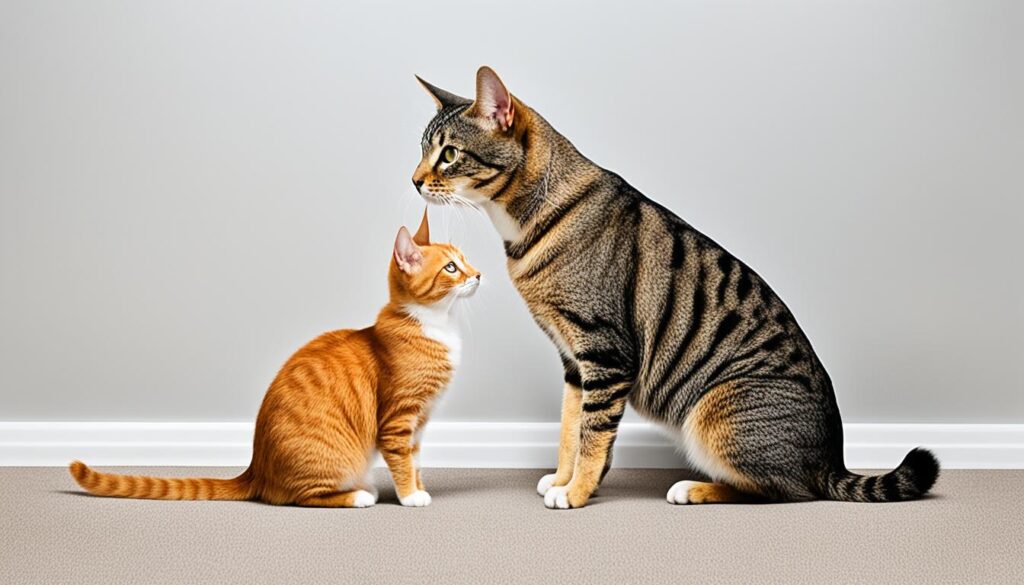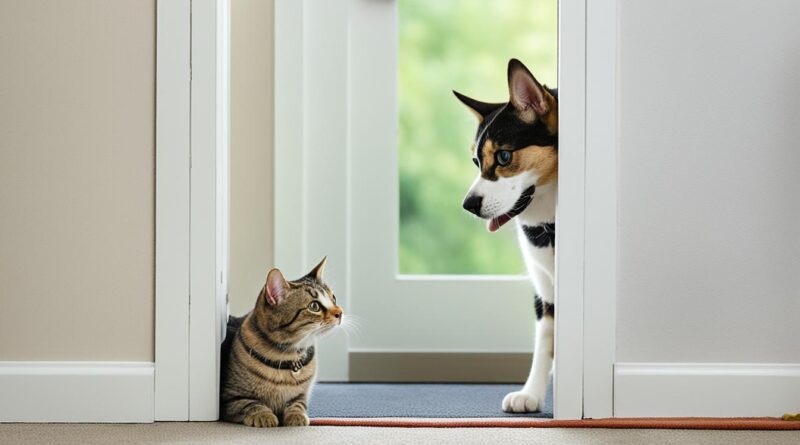Safe Cat-Dog Introduction Guide | Pet Harmony Tips
Introducing a new cat to a resident dog can be a delicate process, but with the right approach, you can create a harmonious household for your furry friends. By following these step-by-step tips on how to introduce a cat to a dog safely and successfully, you can ensure a smooth transition and foster a positive relationship between your pets.
Before diving into the introduction process, it’s crucial to understand the individual personalities and traits of your cat and dog. Taking the time to observe their preferences and behaviors will guide your approach and help create a comfortable environment for both animals.
To ensure a successful introduction, it’s important to take it slow. Rushing the process can lead to conflicts and stress for both pets. Start with short, supervised meetings in a neutral space, using positive reinforcement techniques such as treats and praise to create a positive association between the cat and dog.
Creating a safe environment for both pets is essential during the introduction process. Set up spaces where your cat can retreat and feel secure, such as cat trees or designated cat-only areas. It’s also helpful to swap bedding between the two pets to familiarize them with each other’s scents. Monitor their interactions closely and respect their boundaries.
Remember, introducing a cat to a dog requires patience, understanding, and careful planning. If needed, seek professional help for guidance. With time and proper introduction techniques, your cat and dog can become best friends and bring joy to your household.
Key Takeaways:
- Take the time to understand the personalities and preferences of your cat and dog.
- Start the introduction process slowly, with short, supervised meetings in a neutral space.
- Use positive reinforcement techniques, such as treats and praise, to create a positive association.
- Create a safe environment with designated spaces for your cat and swap bedding to familiarize them with each other’s scents.
- Monitor their interactions closely and respect their boundaries.
Understanding Your Pets
Before introducing your cat and dog, it is important to understand their individual personalities and traits. Take the time to observe your pets and learn about their preferences and behaviors. This knowledge will guide your approach and help you create a comfortable environment for both animals. Consider factors such as your dog’s reaction to cats, your cat’s comfort level with dogs, and the age and previous experiences of both pets.
- Observe your pets: Spend time watching how your cat and dog behave in different situations. Note their body language, reactions, and preferences.
- Research breed tendencies: Understand the typical characteristics and instincts of your cat’s and dog’s breeds. This can provide insights into their behavior during the introduction process.
- Evaluate your dog’s reaction to cats: If your dog has never interacted with a cat before, it is essential to gauge their interest, curiosity, or potential prey drive towards cats.
- Consider your cat’s comfort level with dogs: Some cats may have had negative experiences with dogs in the past, leading to fear or anxiety. Take this into account when planning the introduction.
- Take age and previous experiences into consideration: Younger animals may be more adaptable to new situations, while older pets may require more time and patience. Additionally, past positive or negative experiences with other animals can influence their behavior during introductions.
By understanding your pets’ personalities and traits, you can create a personalized approach to introducing your cat and dog, increasing the chances of a successful and harmonious integration.
“Knowing your pet’s personality and behaviors is key to a successful cat-dog introduction. By observing how they interact with other animals and understanding their breed tendencies, you can plan an introduction strategy that suits their individual needs.”
Taking it Slow
When it comes to introducing a cat to a dog, one of the most important steps is to take it slow. Rushing the process can result in conflicts and stress for both animals. By implementing cat and dog integration techniques that prioritize a gradual approach, you can increase the likelihood of successful cat and dog introductions.
Start by organizing short, supervised meetings between your cat and dog in a neutral space. This allows them to become acquainted without triggering territorial instincts. Keep these initial interactions brief to prevent overwhelming either pet.
During these meetings, use positive reinforcement techniques to create a positive association between your cat and dog. Offer treats and praise as rewards for calm and friendly behavior. This helps to foster a sense of safety and trust.
As your pets become more comfortable with each other, gradually increase the duration of their meetings. Monitor their interactions closely to ensure they are progressing in a positive direction. If any signs of tension or aggression arise, separate them and consult with a professional trainer or behaviorist for guidance.
“Introducing a cat to a dog requires patience and a methodical approach. Taking it slow allows both animals to adjust at their own pace, minimizing stress and increasing the chances of a successful integration.” – Dr. Maya Patel, Animal Behavior Specialist
Remember, every cat and dog pair is unique, and the timeline for successful integration may vary. It’s important to be patient and let their relationship develop naturally. With time, patience, and the right techniques, you can facilitate a harmonious bond between your cat and dog.

Expert Tip: Establish Separate Safe Spaces
To help your cat and dog feel secure during the integration process, it’s essential to create separate safe spaces for each pet. This allows them to retreat and have their own territory, reducing potential conflicts. Consider setting up a cozy cat tree or designating specific areas where your cat can find solitude. Providing these safe spaces promotes a sense of reassurance and aids in a smooth introduction.
Creating a Safe Environment
When introducing a cat to a dog, it’s crucial to provide a safe environment for both pets. By following these best practices, you can ensure a smooth and stress-free introduction process:
- Set up designated spaces: Create areas where your cat can retreat and feel secure. Cat trees, hiding spots, or even a separate room can provide a sense of safety for your feline friend.
- Swap bedding: To familiarize your cat and dog with each other’s scents, consider swapping bedding between them. This can help both pets become accustomed to the presence of the other.
- Monitor interactions closely: During initial meetings, supervise your cat and dog closely. This allows you to intervene if any signs of aggression or discomfort arise.
- Respect boundaries: Each pet needs time to adjust to the other’s presence. Respect their boundaries and avoid forcing interactions before they are ready.
Remember, patience is key when introducing a new pet into your household. Providing a safe environment will promote a positive and gradual relationship between your cat and dog.

Conclusion
Introducing a cat to a dog requires patience, understanding, and careful planning. It is a process that should not be rushed. By following the steps outlined in this guide, you can increase the chances of a successful introduction and create a harmonious relationship between your pets.
Remember to take it slow and gradually introduce your cat and dog in supervised meetings. Use positive reinforcement techniques, such as treats and praise, to create a positive association. Provide a safe environment by setting up spaces where your cat can retreat and feel secure. Monitor their interactions closely and respect their boundaries.
If you encounter any difficulties or feel overwhelmed, don’t hesitate to seek professional help. With time and proper guidance, your cat and dog can become best friends and bring joy to your household. Good luck on your journey to pet harmony!
FAQ
How do I introduce a cat to a dog?
To introduce a cat to a dog, start with short, supervised meetings in a neutral space. Use positive reinforcement techniques and gradually increase the duration of the meetings as they become more comfortable with each other.
What should I consider before introducing a cat and dog?
Before introducing a cat and dog, consider their individual personalities, their comfort levels with each other’s species, and their previous experiences. This knowledge will guide your approach and help create a comfortable environment for both pets.
How can I create a safe environment for my cat and dog?
Create spaces where your cat can retreat and feel secure, such as cat trees or designated cat-only areas. Swap bedding between the pets to familiarize them with each other’s scents. Monitor their interactions closely, respect their boundaries, and give them time to adjust to each other’s presence.
How long does it take for a cat and dog to become friends?
The time it takes for a cat and dog to become friends can vary. Some may bond quickly, while others may take weeks or even months. Patience, understanding, and careful planning are key during the introduction process.
What should I do if the cat and dog are not getting along?
If the cat and dog are not getting along, seek professional help, such as consulting a veterinarian or animal behaviorist. They can provide guidance and create a customized plan to address the specific issues and help foster a positive relationship between your pets.
Source Links
- https://www.fearfreehappyhomes.com/introducing-cats-and-dogs-how-to-help-ensure-harmony-in-the-home/
- https://petharmonytraining.com/7-tips-for-introducing-a-new-dog-or-cat-to-your-resident-pets/
- https://amanireign.com/blogs/news/p-span-style-font-weight-400-🐾-span-b-bringing-harmony-home-10-step-guide-to-introducing-cats-amp-dogs-b-p-p-nbsp-p


